Report

At a Glance
- Environmental, social, and governance (ESG) initiatives are increasingly becoming prioritized by customers and employees throughout the Asia-Pacific region and the world.
- Bain & Company and APACMed partnered to survey 120 customers and more than 800 employees on ESG considerations within the medtech industry.
- Medtech companies can choose to balance current competitiveness and future investments while connecting ESG to economic value.
- ESG in medtech requires collective industry action along three key objectives: sharing best practices, proactive dialogue, and tangible results driven by industry-wide initiatives.
Written in collaboration with
Written in collaboration with

Foreword
As a new era for the medtech industry in the Asia-Pacific region approaches, the integration of ESG considerations emerges not merely as a trend but as an imperative.
The upcoming decade promises rapid advancements in medical technology, intertwined with an intensified focus on sustainability and ethical governance. The industry can expect innovations catering to medical needs while prioritizing environmental and social concerns. The ascent of digital health solutions, telemedicine, and AI-driven diagnostics will revolutionize patient care and reduce the carbon footprint by minimizing reliance on physical infrastructure and transportation.
Challenges are inevitable. Evolving regulatory landscapes, shifting consumer expectations, and the global economic milieu will present unforeseen obstacles. Yet within these challenges lie unparalleled opportunities. Medtech companies that wholeheartedly embrace ESG will position themselves as market leaders and vanguards of thought and innovation. These trailblazers will set industry benchmarks, influence policy frameworks, and command consumer trust.
Collaboration remains paramount. Governments, industry stakeholders, investors, and consumers must work together to create an ecosystem that champions innovation while upholding ESG tenets. Endeavors such as cross-border research collaborations, sustainability-centric investment portfolios, and consumer education campaigns can expedite the industry’s trajectory toward a sustainable future.
This report is a collaboration between APACMed and Bain & Company and brought together 15 member companies from APACMed to develop an online, comprehensive dashboard of environmental regulations specific to the medtech value chain across six markets in APAC. This was supplemented by surveys of 120 customers and more than 800 employees and various executives from medtech companies to better understand how stakeholders’ changing expectations are reinforcing the importance of ESG as a strategic priority for companies.
The medtech landscape in the Asia-Pacific region stands on the brink of transformative growth. By embedding ESG in the core of this metamorphosis, the industry can ensure growth that is exponential, responsible, resilient, and aligned with cherished values.
— Harjit Gill (APACMed, CEO) and Vikram Kapur (Bain & Company, Senior Partner, Singapore)
Why ESG matters for medtech in the Asia-Pacific region
Society is transitioning to foster sustainable development in energy, mobility, food, health, resources, circularity, community, and finance. The United Nations member states outlined 17 Sustainable Development Goals (SDGs) in 2015 to promote holistic growth across social, economic, and environmental aspects.1 These SDGs have played an essential role in creating a global framework for sustainable development, which has led to a growing focus on environmental, social, and governance (ESG) priorities. Notably, customer awareness of ESG considerations is also rising, propelling companies to integrate sustainable practices and highlighting the pivotal link between responsible business practices and customer loyalty. However, the medtech industry faces unique challenges in aligning with these global goals, especially in the diverse Asia-Pacific region, which is growing at a rapid rate.
The Asia-Pacific region represents 18% of the approximately $660 billion global medtech industry and is projected to be the fastest-growing region, with a 9% compound annual growth rate over the next five years.2 With this growth, global and domestic champions will continue expanding their commercial, manufacturing, and supply chain footprint in the region.
The concerted efforts of medtech firms in the Asia-Pacific region demonstrate their commitment to contribute to ESG targets and foster sustainable development. Medtech companies are proactively addressing various ESG issues and have launched numerous initiatives. These include energy-efficient manufacturing, supply chain engagement, recycling, waste reduction, remanufacturing, and eco-material adoption. Additionally, medtech firms continue to focus on improving healthcare access, community engagement, diversity, and inclusion. Further acknowledging the importance of ethical business practices and transparency, medtech companies in the Asia-Pacific region have restructured their standard operating procedures and offered supplementary compliance training for employees.
ESG is an important strategic priority for medtech companies
Rising expectations across all stakeholder groups, including policymakers, investors, customers, and employees, reinforce the importance of ESG as a critical strategic priority for medtech companies. This commitment to ESG targets has led to a significant transformation of the ESG practices landscape. This trend reflects a broader shift toward responsible and ethical business conduct, spurred by the collaborative efforts of governments and industries to tackle pressing environmental and social challenges. More than 35 Asia-Pacific countries have committed to reducing greenhouse gas (GHG) emissions.3 Furthermore, as of August 2021, the Asia-Pacific region had witnessed a twofold increase in ESG policies compared to 2016, totaling more than 200 policies and amendments.4
In addition to the changing policy landscape, investor expectations are rapidly evolving. Eighty-two percent of asset managers globally factor ESG considerations in their investment processes,5 and approximately 60% of global investors foresee ESG becoming standard practice within the next five years.6 The Covid-19 pandemic has further propelled this trend, as 79% of Asia-Pacific investors have substantially or moderately increased the integration of ESG criteria into their investment strategies.7 The Asia-Pacific region notably witnessed an impressive fivefold surge in ESG securities issued in 2021 compared to 2016, underscoring an expanding appetite for sustainable investments.8
Not only investors but also medtech customers across the Asia-Pacific region are highlighting the growing importance of ESG considerations. More than 70% of 120 medtech purchasing decision makers from Australia, China, India, Japan, South Korea, and Vietnam indicated that their organizations had already defined ESG strategies adopting ambitious objectives, precise metrics, and quantifiable targets.9 Notably, China and Australia are at the forefront of this movement, with more than 90% of surveyed customers possessing well-defined ESG strategies.
Fifty-three percent of surveyed customers anticipate that the significance of ESG criteria in their organization’s supplier selection will rise over the next two years, with 69% expecting a further increase in importance over the next five years. The majority of respondents from Australia (85%) and China (60%) predict their organizations will prioritize ESG factors in their key purchasing criteria within two years, while respondents from India, South Korea, Vietnam, and Japan came in below the Asia-Pacific average for planning to integrate ESG considerations into supplier selection processes (see Figure 1).
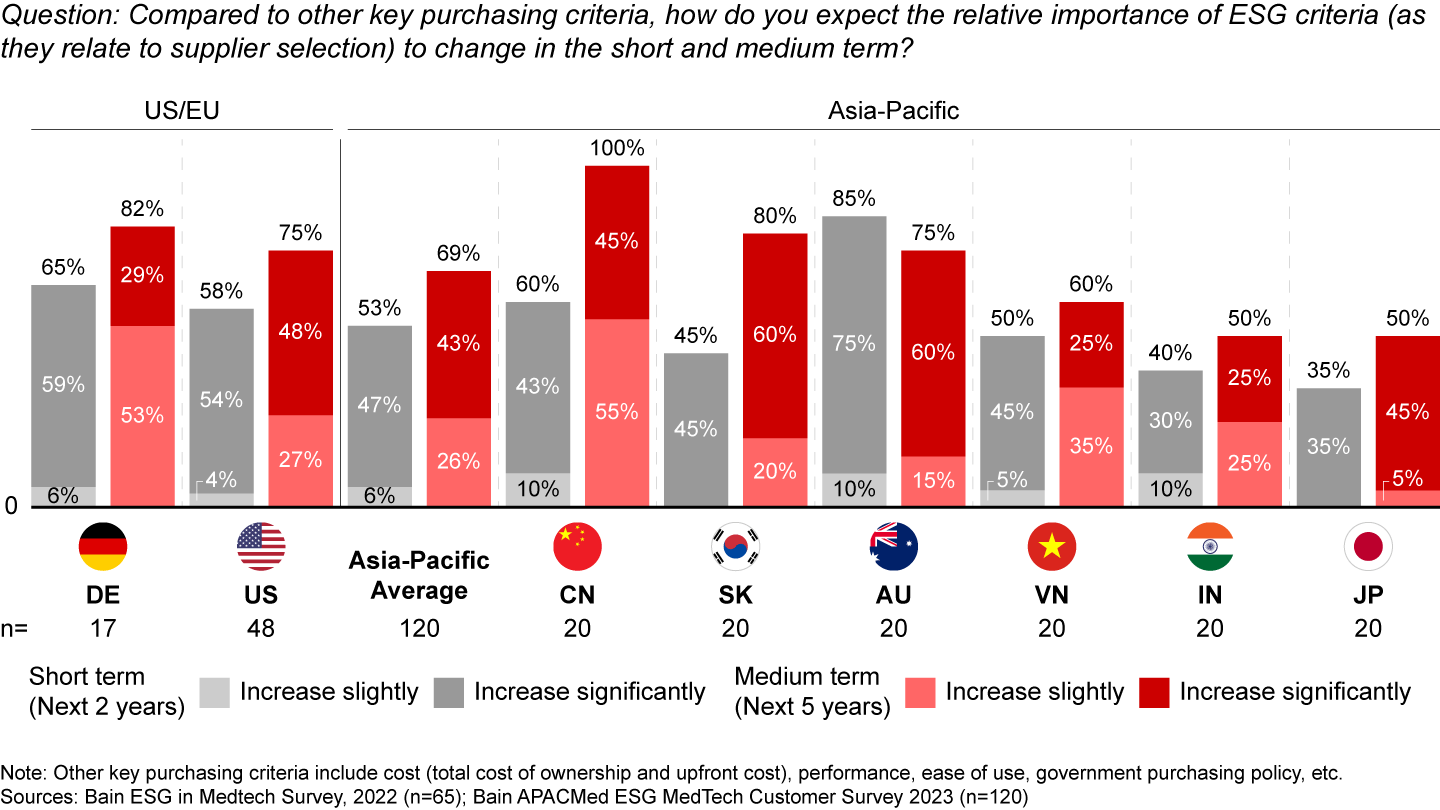
The growing emphasis on ESG initiatives is shaping customer expectations and significantly impacting the perspectives and aspirations of employees throughout the Asia-Pacific region. Among the 874 employees surveyed, 60% reported that their companies have already established ESG ambitions and set specific targets, while 43% confirmed the existence of separate ESG strategies for their companies’ suppliers.10
Why environmental stewardship is critical
If the global healthcare industry were a country, it would rank as the fifth-largest GHG emitter in the world. It is responsible for approximately 4.4% of carbon dioxide equivalent (tCO2e) global emissions.11 Approximately 71% of these emissions are classified as Scope 3,12 primarily driven by production, transportation, and disposal processes deeply intertwined within the healthcare supply chain. Notably, fossil fuel combustion accounts for more than 50% of the healthcare industry’s climate footprint, with the majority of emissions classified as Scope 2 and Scope 3.13 While medtech represents a smaller but important part of the broader healthcare industry, there is a growing acknowledgment within the medtech community about the need to address these environmental challenges collaboratively.
If companies do not act to mitigate adverse environmental impacts in the next 5 to 10 years, they are likely to face various consequences, including increased costs. For instance, Singapore plans to increase the carbon offset price to $33/tCO2e in 2026–27, reaching $59/tCO2e by 2030.14 Similarly, China15 and South Korea16 could experience carbon price increases of around 34% and 25%, respectively, by 2030. India’s carbon prices are also expected to reach $80/tCO2e17 by 2050 with the introduction of a carbon market.18 Other Asia-Pacific countries, including Vietnam, are also examining carbon trading mechanisms to monetize GHG emissions reductions.
Environmental sustainability policies are progressively tightening in the Asia-Pacific region, with more than 15 Asia-Pacific countries committing to ambitious net-zero emissions objectives in the past five years. Consequently, a transition toward mandatory climate disclosures and significant emissions reductions by 2030 is underway. For instance, the Australian government intends to mandate climate-related financial disclosure requirements from 2024, placing a greater emphasis on companies adopting environmentally responsible practices. Moreover, stringent waste disposal regulations are on the horizon, with Japan19 and South Korea20 targeting 25% and 50% reductions in plastic waste, respectively, by 2030. Consequently, the medtech industry and the broader healthcare sector are increasingly embracing environmental stewardship.
While other factors such as compensation, good products, and benefits remain table stakes for employment decisions, environmental leadership is becoming an emerging consideration and is expected to increase over time. Three-quarters of surveyed Asia-Pacific medtech employees consider environmental impact an important criterion when selecting employers. Approximately 70% of employees indicate a greater willingness to work for a company known for its efforts in reducing GHG emissions, while 74% of employees express reservations about working for companies that have a high negative environmental impact (see Figure 2).
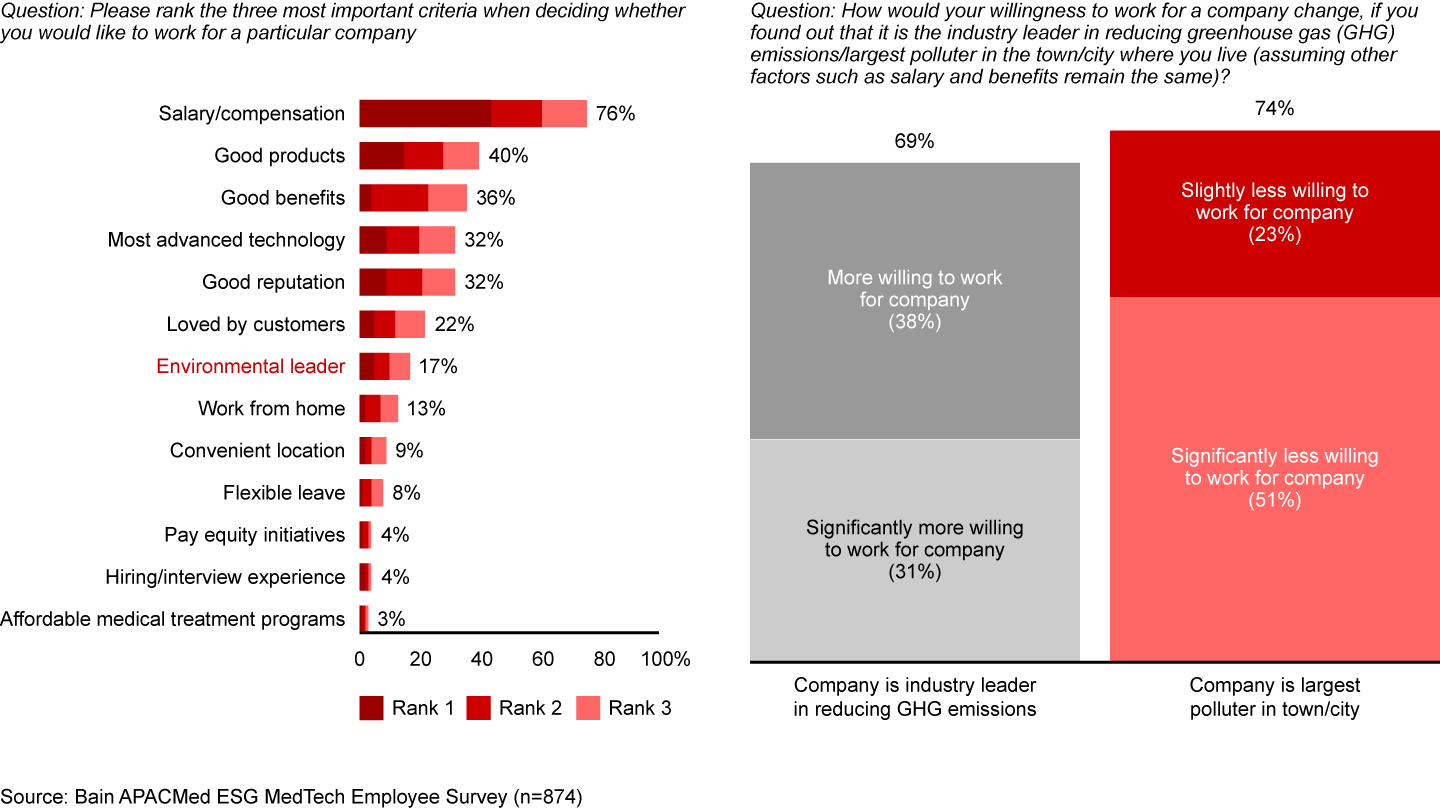
While employees are weighing environmental performance in selecting employers, companies are increasingly considering environmental factors in the supplier selection process within the Asia-Pacific medtech industry. Approximately 23% of surveyed customers prioritize environmental considerations alongside product quality and cost when selecting suppliers. The importance of environmental factors is expected to increase in the next two years, with 30% of surveyed customers ranking it as a top-three criterion when selecting medtech suppliers (see Figure 3).
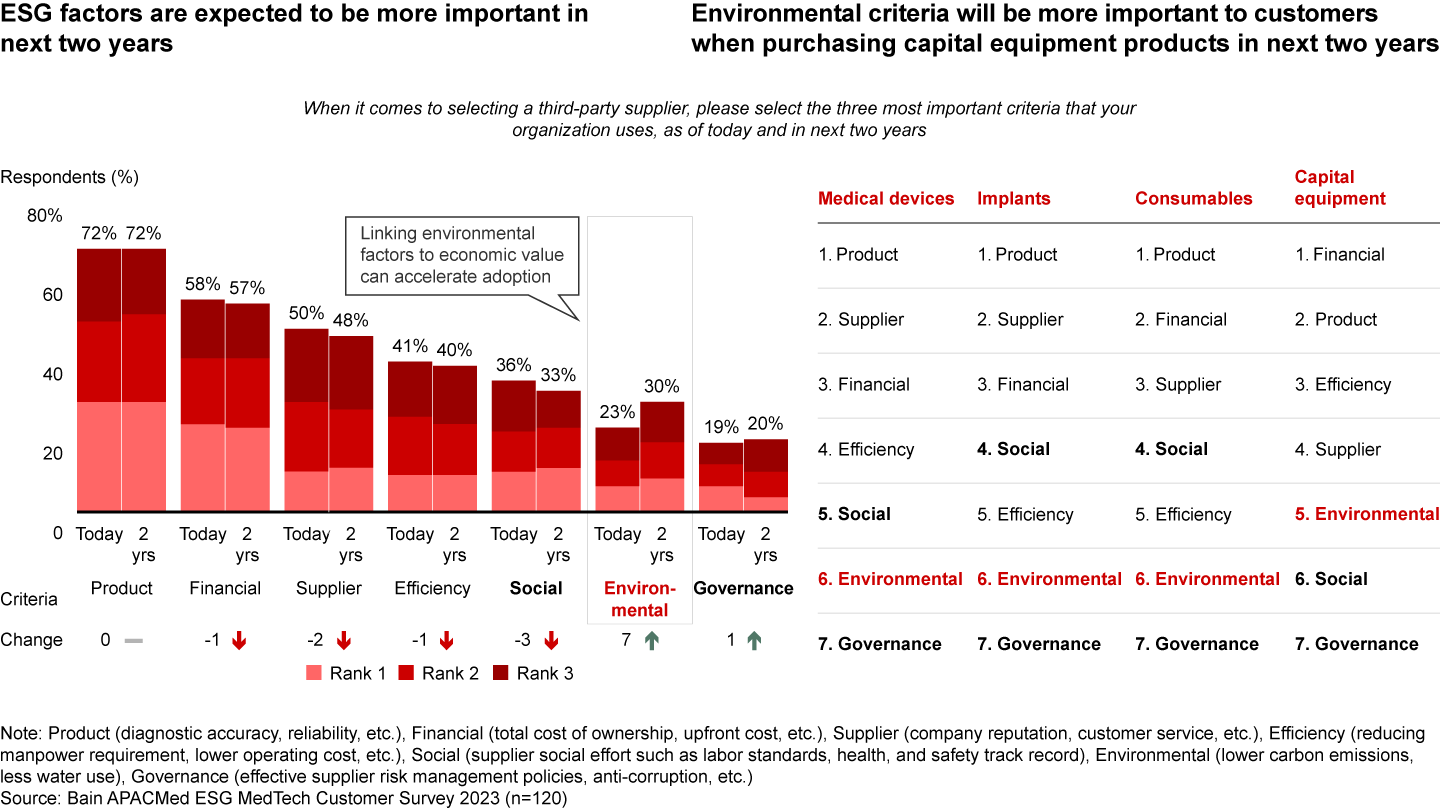
Professionals within medtech organizations also view environmental factors as vital. A substantial portion (89%) of customer-facing teams classify environmental issues as crucial to their company’s daily operations. This sentiment is echoed at the executive level, with 85% of executives recognizing the significance of environmental issues in shaping their organization’s day-to-day activities.
In conclusion, the growing expectation of stakeholders to adopt sustainable practices, coupled with the evolving regulatory environment, is raising the stakes for businesses within the region.
Challenges exist, but so do opportunities
As medtech companies continue to develop the “environment” aspect of their ESG agendas, there are several challenges but also an ecosystem of support, opportunities, and incentives in a growing number of markets. The environmental policy landscape in the Asia-Pacific region displays varying degrees of maturity, which introduces a nuanced layer of complexity for medtech companies.
For instance, Australia stands out as a leader in ESG maturity, implementing a comprehensive array of regulations and covering a wide range of policies related to environmental matters at both state and national levels. Furthermore, the medtech industry in Australia encounters specific requirements and incentives designed to encourage sustainable practices, such as the National Reconstruction Fund, which supports sustainable projects in priority sectors such as medical science and devices through equity, loans, or guarantees. Similarly, countries such as China, Japan, and South Korea have made significant progress in environmental policies over the past five years, emphasizing the reduction of energy intensity and the pursuit of carbon neutrality. Circularity initiatives around sustainable material use and waste management in these nations are also gaining traction and are anticipated to experience increased adoption in the years ahead.
On the other hand, countries such as India and Vietnam remain in the nascent stages of environmental development. These markets are currently creating more environment-specific rules, including those designed to address the unique needs of the medtech sector (see Figure 4).

Such a diverse environmental policy landscape across the Asia-Pacific necessitates substantial resources from medtech companies to guarantee compliance. Maneuvering through the intricate and constantly evolving policy frameworks imposes considerable financial and operational strains on these manufacturers. The absence of comparable and reliable data presents difficulties for companies when they are trying to make well-informed ESG-related investments and business decisions.
Despite the lack of comparable and reliable data, medtech companies are approaching new environmental regulations proactively. Given the industry-agnostic nature of many environmental policies, medtech companies often need time to adapt effectively. Obstacles include regulatory requirements (including sterility mandates) when transitioning from single-use to reusable products, blanket bans on single-use plastics in India without clear alternative plans, and challenges related to repackaging and cross-border regulations.
Nonetheless, some policies offer exemptions for the medtech industry, potentially serving as models for ecosystem support in other markets to prevent disruptions and impacts on the accessibility of products. For example, Australia (New South Wales)21 exempts the supply of single-use plastics for medical purposes, while South Korea22 exempts medical devices from hazardous material restrictions, recycling, and take-back obligations. In India,23 certain medical and surgical equipment that does not generate effluents or emissions during operation is exempted from the requirement to obtain a “No Objection Certificate” from the pollution control board. Stakeholder engagement on ESG aspects presents untapped opportunities for medtech companies. By collaborating with governments, civil society organizations, and other broader communities, these firms can use their expertise and interests to elevate ESG standards within the medtech industry.
The medtech industry’s response to ESG concerns is also driven by customer requirements, which can vary across Asia-Pacific markets. Although traditional key purchasing criteria such as price and product quality remain paramount, environmental factors are increasingly influential in supplier selection for Australian customers. For example, approximately one-third of surveyed customers in Australia rank environmental considerations among their top three criteria for supplier selection, with 40% expecting this to be the case in two years. Among these environmental considerations, electronic waste management and product circularity are rated as the most important criteria for supplier selection. In contrast, only 18% of surveyed customers in Vietnam and South Korea rate environmental factors as one of their top three purchasing criteria.
On the other hand, employees in developing markets perceive environmental issues as more critical than their counterparts in developed markets. More than 90% of surveyed employees in India and Vietnam consider environmental factors important in their daily lives and their companies’ operations. Furthermore, about 78% of surveyed employees in these two markets agree that environmental stewardship is a crucial driver for attracting talent (see Figure 5).
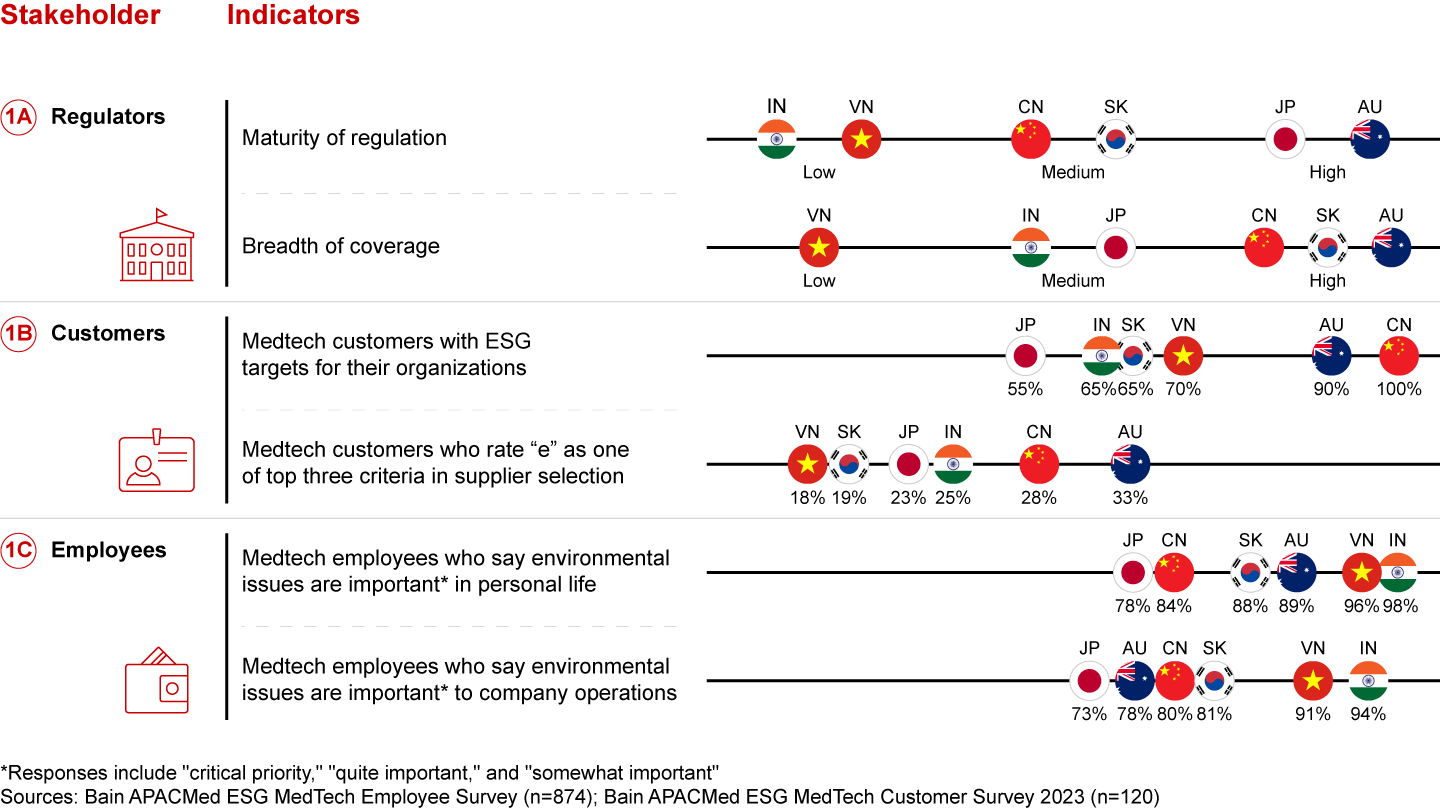
The significance of ESG factors, as perceived by customers, employees, and other stakeholders, varies by region. While Europe and the Asia-Pacific have made noteworthy progress in this regard, US-based organizations are comparatively lagging. The challenge lies in devising ESG strategies that cater to the distinctive regional requirements, while ensuring enterprise-wide compliance with critical measures such as GHG reporting and addressing Scope 3 emissions in the supply chain.
Medtech companies in Asia-Pacific have a unique window of opportunity to fully unlock their ESG potential
The medtech industry in the Asia-Pacific region should play a significant role in collaborating on global ESG strategy development and shaping regional and country-specific priorities and initiatives. Successful medtech companies emphasize global sustainability while recognizing the importance of addressing local market nuances and engaging with local stakeholders.
Numerous healthcare and medtech leaders have effectively executed ESG initiatives addressing vital environmental issues within the region. For instance, a global diagnostic company is working with waste and recycling partners in Australia to dispose of and manage end-of-life instruments properly. Similarly, a global medical devices company partnered with the Japan Containers and Packaging Recycling Association for waste recycling. In 2021, the company recycled 31 tons of paper and 207 tons of plastic packaging materials with the help of contracted recycling firms of the association. Organizations can generate tangible customer value, attract and retain talent, and align with local government priorities by implementing initiatives tailored to local market intricacies and engaging with local stakeholders.
While medtech companies understand the importance of ESG initiatives, healthcare investment as a proportion of GDP in many Asia-Pacific markets falls short of the appropriate level, with access to care continuing to be a significant concern. This lack of investment has a cascading effect on pricing and reimbursement for innovative medtech, resulting in disparities compared to other regions and markets. Medtech companies can choose to balance current competitiveness and future investments while connecting ESG to economic value. Many of these companies have employed various strategies to demonstrate the value of their ESG initiatives to key stakeholders. For instance, a medical device company enhanced energy efficiency across its Asia-Pacific manufacturing sites and offices, resulting in substantial operating cost savings. Another medtech firm specializing in consumables redesigned products to be more environmentally friendly by using less plastic material in their new-generation intravenous (IV) infusion pumps and IV solution bags, addressing key customer needs and promoting sustainability. These ESG efforts translate into improved business value while fostering sustainability.
Successful medtech companies deliver on “table stakes” (topics important to a broad range of stakeholders, where they aim to set objectives and achieve various benefits) while strategically selecting areas where they can “reach for the stars” (topics where they seek to create a differential competitive advantage with key constituents). Several factors can help determine in which areas companies should “reach for the stars,” including identifying material ESG issues specific to the subindustry or product mix, understanding critical stakeholders’ concerns, and leveraging global competitive advantages to surpass regulatory requirements and the regional competitive baseline.
At the same time, implementing sustainability-focused changes presents challenges, requiring a shift in organizational culture and approaches. Sustainability must be incorporated into every facet of the business with flexible scenarios and incremental steps over rigid plans. Investments in new capabilities and skill sets, as well as a focus on scalability and adaptability, are crucial for achieving a capability shift. Furthermore, collaborating with unexpected allies, such as renewable energy providers, government agencies, educational institutions, and environmental nongovernmental organizations, is vital for effectively driving systemic change.
ESG requires collective industry action, encompassing three key objectives to pave the way forward
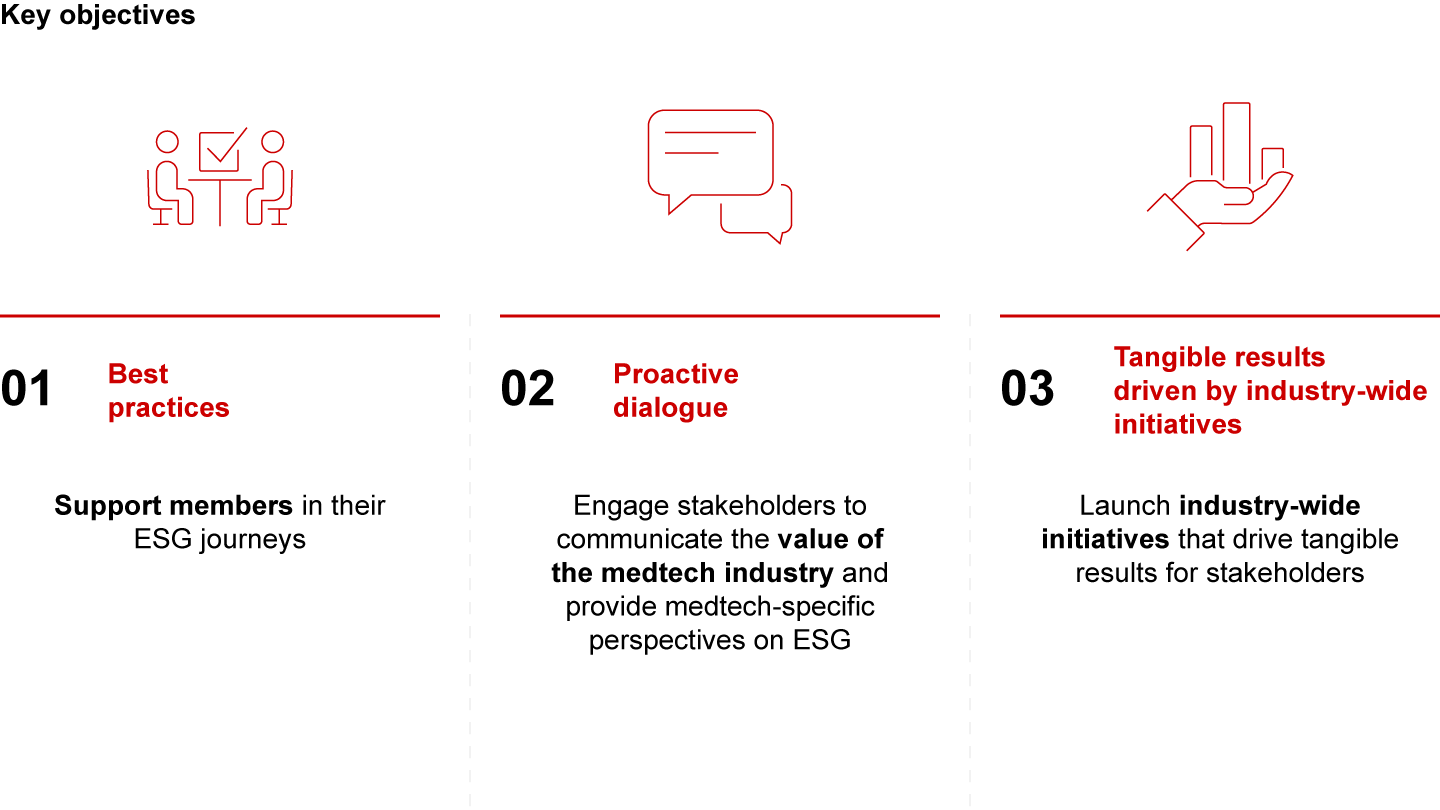
1. The medtech industry in the Asia-Pacific region should take proactive measures to enhance its ESG capabilities and promote the exchange of best practices (see Figure 6).
- In the short-to-medium term, APACMed is curating and maintaining a repository of ESG resources tailored to each country’s specific nuances, catering to the needs of key stakeholders such as regulators, customers, and employees. Furthermore, an online dashboard has been developed to track the evolving environmental regulations in six key Asia-Pacific markets, providing a comprehensive overview of requirements. This dashboard aids medtech companies in navigating the market and effectively addressing particular environmental themes.
- APACMed also aims to periodically update environmental regulatory developments in the region, benefiting the entire medtech industry, including small- and medium-sized enterprises, start-ups, and smaller companies that may lack dedicated ESG resources. This includes proactively scanning for upcoming ESG-related developments in other regions through regular touchpoints with trade associations such as Medtech Europe and Advanced Medical Technology Association globally, and associations within the Asia-Pacific region, such as the Medical Technology Association of Australia, among others.
- In the long term, the medtech industry can establish a center of excellence to facilitate the sharing of best practices, educate stakeholders on the challenges and needs of medtech, and partner with educational institutes to develop curriculum and training programs.
2. The medtech industry should proactively engage in dialogue with stakeholders, emphasizing healthcare considerations and unique factors that should be accounted for in crafting fit-for-purpose ESG regulations for the medtech sector.
- The value and positive impact that medtech brings to society need to be communicated in the right manner: Medtech has made contributions to improving health outcomes and patient experiences, advancing population health, and reducing overall costs of care, making care more accessible. Through partnerships with healthcare stakeholders, medtech consistently explores disruptive solutions to ensure patients have access to the right care in the right format at the right time.
- An advocacy platform can be employed to collaborate with policymakers, underscoring the importance of industry consultation on policy changes that impact the sector. Advocating for and supporting carve-outs, grants, and incentives that promote sustainable practices, innovation, and investment in environmentally responsible solutions is crucial. This collaboration will enable sufficient transition time, ensuring compliance without compromising product quality and safety.
- Capitalizing on its role as an innovation catalyst, the medtech industry should encourage collaboration within its own system to provide potential solutions or recommendations for future policy developments. Participation in multilateral platforms, forums, conferences, and working groups can be critical in shaping the ESG agenda and promoting environmental stewardship within the medtech industry.
3. To substantially impact and address critical environmental issues in the medtech sector, it is vital to pursue industry-wide initiatives concentrating on one or two urgent challenges. These initiatives should be tailored to address each country’s unique insights and requirements, delivering tangible results that benefit local stakeholders.
- To efficiently confront material issues related to environmental stewardship, establishing dedicated technical working groups comprising industry experts and stakeholders is essential. Through collaborative endeavors, these groups can devise and launch industry-wide initiatives that directly target the identified environmental challenges.

About APACMed
The Asia Pacific Medical Technology Association (APACMed) represents manufacturers and suppliers of medical equipment, devices, and in vitro diagnostics, industry associations, and other key stakeholders associated with the medical technology industry in the Asia Pacific region. APACMed’s mission is to improve the standards of care for patients through innovative collaborations among stakeholders to jointly shape the future of healthcare in Asia-Pacific. For more information, visit www.apacmed.org
Notes
- United Nations, “2030 Agenda for Sustainable Development,” January 2015
- Fitch Solutions, Medical Devices Market Size Data
- United Nations, Economic and Social Commission for Asia and the Pacific, United Nations Environment Programme, United Nations Children’s Fund (2022), “2022 Review of Climate Ambition in Asia and the Pacific: Raising NDC targets with enhanced nature-based solutions,” November 2022
- Goldman Sachs, “GS SUSTAIN: APAC ESG Regulation,” February 2022
- Russell Investments, “ESG Manager Survey,” November 2021
- Natixis Investment Managers, “ESG Investing - Everyone’s on the bandwagon,” April 2021
- MSCI, “MSCI Investment Insights 2021 - Global Institutional Investor survey,” February 2021
- J.P. Morgan, “Asia Pacific ESG Research,” January 2023
- Bain and Asia Pacific Medical Technology Association (APACMed), “ESG MedTech Customer Survey,” May 2023. The survey aimed to gather opinions of medtech customers regarding their suppliers’ ESG considerations in the Asia-Pacific region, specifically in China, India, Japan, Korea, Vietnam, and Australia. It focused on understanding customers’ existing and future perspectives on ESG maturity, strategies, and primary selection criteria for third-party providers across Asia-Pacific markets. The survey targeted large healthcare providers (20 healthcare providers per market, with no more than one respondent from the same company) in the six key markets, spanning public hospitals, private not-for-profits, and private for-profits; respondents had major responsibility for purchasing decisions.
- Bain and Asia Pacific Medical Technology Association (APACMed), “ESG MedTech Employee Survey,” May 2023. The survey aimed to gather opinions from employees within medtech companies in the Asia-Pacific region regarding ESG considerations. It focused on employees’ views on the importance of environmental stewardship, whether ESG initiatives attract talent in hiring efforts in Asia-Pacific, and whether customers care about environmental sustainability today and in the short-to-medium-term future. The survey targeted employees in China, India, Vietnam, Japan, South Korea, and Australia and included regional headquarters employees in Singapore, Malaysia, or Hong Kong overseeing Asia-Pacific markets.
- Healthcare without Harm & ARUP, “Health Care’s Climate Footprint,” September 2019. Healthcare industry includes all organizations, institutions, and resources devoted to producing health, actions ranging from hospitals and ambulatory care to ancillary services, preventive care, pharmacies, administration, financing.
- Scope 1 emissions refer to direct emissions from company-controlled sources; Scope 2 emissions refer to indirect emissions from purchased energy; Scope 3 emissions refer to indirect emissions from external activities, including supply chain and product use
- Healthcare without Harm & ARUP, “Health Care’s Climate Footprint,” September 2019
- Reuters, “Asia's carbon pricing and emission trading systems,” March 2023
- S&P Global, “Commodities 2023: China's carbon market to slow in 2023 as energy security, economy take priority,” January 2023
- The World Bank, “Carbon Pricing Dashboard,” May 2023
- S&P Global Market Intelligence, “India may announce details of national carbon market scheme this year,” March 2023
- The Hindu, “Time to put a price on carbon emissions,” April 2023
- Plastic Atlas Asia, “Japan’s Plastic Waste Management – Challenges and Potential Solutions,” May 2022
- MDPI, “New policy framework with plastic waste control plan for effective plastic waste management,” July 2020
- NSW Environment Protection Authority (EPA), “Plastic Reduction and Circular Economy Bill,” 2021
- Ministry of Environment (Resource Recycling Division), “Draft Revision of Act on Resource Circulation of Electrical and Electronic Equipment and Vehicles, South Korea,” 2023
- Central Pollution Control Board (CPCB), “Classification of Industrial Sectors into Red, Orange, Green and White Categories: A Tool for Progressive Environmental Management,” 2016





